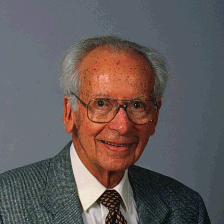
His graduate advisor was Donald Hanahan, who now is professor emeritus at the University of Texas Health Sciences Center in San Antonio. "I knew someone at Hopkins and I called him about Marty," Hanahan recalls. "I got good vibrations about him."
Biochemistry was a new department at the time, but it had an outstanding core of faculty members, including Edwin Krebs and Edmond Fischer, who would win the Nobel Prize for Medicine in 1992.

"We lived in Union Bay Village, which was a bunch of old Army barracks at the time, for $32 a month," Rodbell says. "We were all in the same boat, beginning to have families. Our first child, Paul, was born there. We were all poor, but it was a great life."
Barbara Rodbell continued her interest in the theater. She found an abandoned auditorium and started her own theater group, the Great Plays Company. Rodbell even turned up on stage once, as the truck driver in e.e. cumming's Santa Claus.
The company was doing well when a director absconded with all the money. "That was the end of it," Rodbell says, though his wife continued to perform, including in a UW drama school production of Chekhov's Uncle Vanya.
The central stage in his life was Hanahan's lab. Rodbell was trying to work out how the liver made a lipid cell that formed part of the cell membrane. Through trial and error, he found that the molecule ATP greatly accelerated the synthesis of the lipid.
"I was about to publish this when a professor at Harvard published a paper that showed it was a molecule called CTP that was responsible for the production of the lipid," Rodbell says. He was crushed. Where did he go wrong, he asked himself. The Harvard professor called him and they discussed the research. "Well, what you've found," the professor said, "is that ATP can be contaminated." In this case, some CTP got into the compound.
It was a lesson he'd never forget. ATP comes from rendering houses--often it is derived from horse muscle--and is unlikely to be 100 percent pure. The pitfalls of impure ATP would factor into his later, Nobel prize-winning discoveries.
"There were a number of things he learned at the University that were of value to him," says Hanahan. "He learned the value of research and its pitfalls. He learned the precise way to go about it. And he learned that if 10 percent of your work gets good results, it's great."
The Breakthrough that Led to the Prize
Later Years and the Day of the Award
Science Brief:
Turning It On: How G
Proteins Communicate in the Cell
Return to Rodbell Opening Page